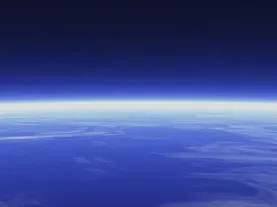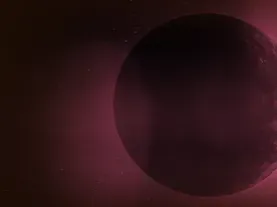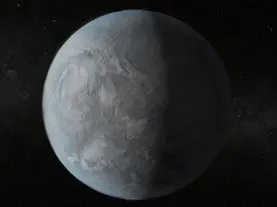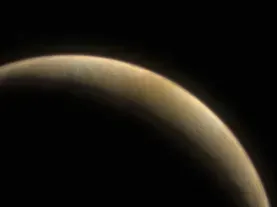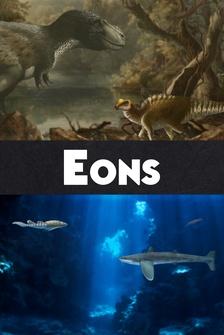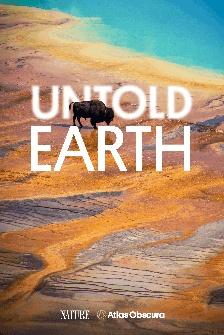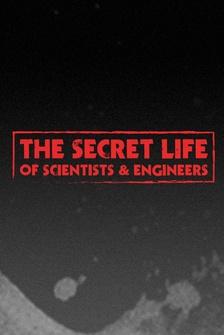ZACHARY QUINTO: Two rocky worlds formed at the same time... (rock crumbling) ...now close neighbors.
One blue with oceans and full of life.
Earth has got this rampant biosphere.
QUINTO: The other a barren desert.
JENNIFER EIGENBRODE: If you look at Mars, it's a red, dusty planet, it's super dry.
♪ ♪ QUINTO: But it hasn't always been that way.
ASHWIN VASAVADA: There's a lot of evidence for ancient flowing water on Mars.
♪ ♪ STEVE SQUYERS: It was a bizarre discovery, it was startling.
QUINTO: Stunning findings reveal a deep mystery... Why is Mars so different from Earth?
QUINTO: ...daring to us to explore... ♪ ♪ VASAVADA: We knew it landed safely when we realized that the wheels sensed the ground.
(rockets firing) We had successfully landed on Mars.
♪ ♪ QUINTO: ...and discover.
EIGENBRODE: What we found in those rocks is a turning point for us.
Finding the organic matter is the clue to searching for life.
♪ ♪ QUINTO: And if life did evolve in its ancient oceans, what happened to it?
SQUYERS: How far along did it get and did it go long enough that life could have taken hold there?
♪ ♪ It opens up the possibility that the universe is full of life.
♪ ♪ QUINTO: "The Planets: Mars" right now, on "NOVA."
♪ ♪ MAN: ...Doppler and orbit around the planet Mars.
("The Void" by Muse playing) ♪ They'll say no one can see us ♪ ♪ That we're estranged and all alone ♪ ♪ They believe nothing can reach us ♪ ♪ And pull us out of the boundless gloom ♪ ♪ They're wrong ♪ ♪ They're wrong ♪ ♪ They're wrong ♪ ("The Void" ends) ♪ ♪ QUINTO: Mars.
Our planetary neighbor is a barren desert world, its surface red with rusted rock and parched sand.
But beneath the dust Mars bears the scars of a former life.
(explosions echo) Four billion years ago, Mars was a very different world... ♪ ♪ ...its atmosphere dense enough to support seas... (waterfall churning) and rivers of running water, what we believe are the conditions for life to emerge.
♪ ♪ But today that vibrant world is gone.
(water flowing, quickly receding) Its rivers run dry.
♪ ♪ Oceans evaporated.
(wind blowing) ♪ ♪ While clearly visible from the red planet's surface, is its neighbor, Earth... blue with oceans and teeming with life.
♪ ♪ EIGENBRODE: On Earth we have this amazing biosphere that is super-vigorous.
There's an ocean, all sorts of things are happening.
If you look at Mars, it's a red, dusty planet, it's super dry.
One of the questions is, "Why are they different?"
Earth has a thick atmosphere, Mars has a very thin atmosphere.
Earth is warm almost everywhere, Mars is freezing cold almost everywhere.
So these are very different planets.
But if you go back into the past, around four billion years ago, the two planets were probably very similar.
♪ ♪ QUINTO: 4.6 billion years ago an innocuous cloud of dust and gas is collapsing, forming the embryonic sun.
(crashing) Swirling around it, the remnants of the dust cloud are slowly drawn together by gravity... forming eight new worlds.
Amongst them: our smaller neighbor, Mars... and our home planet Earth are both rich with elements like carbon, metals like iron, and, crucially, water.
But despite many similarities at birth, their differences in size and distance from the sun set them on very different paths.
These two planets started off very similarly.
It's what I like to call comparative planetary evolution.
The same things could have been happening in the very beginning of their existence.
And then as the clock ticks forward geologically, they actually become very different from each other.
And that's the fascinating part.
What's happened since?
If they looked and acted similar in the very beginning, and life formed on one planet, possibly on the other, then what happened?
MAN (on radio): Five, four... QUINTO: To find out has taken decades of pioneering exploration.
(rockets firing) REPORTER: Mariner 4 was successfully launched on time for its historic 228-day journey to Mars.
♪ ♪ Picture information started to come in on July 15, 1965.
♪ ♪ QUINTO: During its brief flyby, Mariner 4 gives the first close-up glimpses of Mars.
REPORTER: A revelation, comparable to Galileo's first view of the moon through a telescope.
♪ ♪ Beautiful picture.
(chuckling) ♪ ♪ SCIENTIST: First of all, there are two eyes.
Not only in color but also in stereo and in the infrared part of the spectrum.
QUINTO: Viking is the first to successfully land on Mars.
MAN 2 (on radio): Touchdown, we have touchdown.
(cheers and applause) MAN 3: Perfect set down.
♪ ♪ And there's the first piece of information coming in.
MAN 3: Oh, oh.
♪ ♪ QUINTO: But the most surprising revelations come from the rovers-- Spirit and Opportunity.
♪ ♪ (mechanical whirring) Over 50 years of Mars exploration has revealed intriguing clues suggesting Mars has a surprisingly watery past.
♪ ♪ VASAVADA: There's a lot of evidence for ancient flowing water on Mars.
For one thing, there's a lot of rivers that once coursed across the surface that are now dry today.
There's also evidence for floods that catastrophically scoured the surface.
JOHN GROTZINGER: It's undeniable that the early history of Mars was much wetter than it is today.
SQUYERS: The surface of Mars is littered with an uncountable number of little round things.
These blueberries, as we nicknamed them, are what geologists called concretions.
Concretions form typically in sedimentary rocks that are soaked with liquid water.
And so what those blueberries told us was that this was a place where the ground was once soaked.
♪ ♪ GROTZINGER: It might not have been as wet as the earth.
But it was probably wet enough for life to evolve.
What everybody wants to know is whether or not Mars once had life.
♪ ♪ QUINTO: Were conditions on Mars once suitable for life?
To find out, a new generation of spacecraft is investigating... ...led by the most complex mission to the red planet ever attempted.
♪ ♪ (rumbling) (hissing) MAN (on radio): Vehicle reports entry interface.
We have two-way Doppler and orbit around the planet Mars.
♪ ♪ VASAVADA: Mars has a unique set of challenges, compared to other places we go with spacecraft.
Mars has an atmosphere, but it's thin, so it's not enough to really slow you down.
♪ ♪ But it is enough to burn you up as you're trying to land.
♪ ♪ (parachute rustles upon opening) To get Curiosity safely to the surface of Mars, we basically had to pull out every trick in the book.
♪ ♪ QUINTO: At 2,000 pounds, Curiosity is one of the largest and heaviest probes anyone has ever attempted to land in the thin Martian atmosphere.
VASAVADA: We fired rockets, and a jet pack flew the rover down to the surface.
♪ ♪ (jet pack whining) (klaxon blaring, mechanical whirring) (rover thuds) (rockets fire) (wind whistling) ♪ ♪ We knew it landed safely when we realized that the wheels sensed the ground.
♪ ♪ At that point a signal was received, and all of us sort of melted in our seats, knowing that we had successfully landed on Mars.
MAN (on radio): Safe on Mars.
(cheers and applause) ♪ ♪ (mechanical whirring) VASAVADA: Just a few minutes after landing, we had the first images come back.
It's a thrill to see images of a new world, you know, from eye level for the first time.
QUINTO: Curiosity touches down in Gale Crater, the remains of an asteroid impact about a hundred miles wide thought to have been home to ancient lakes and rivers.
(mechanical whirring) VASAVADA: As we drove out of our landing site, we came across what looked like an upturned sidewalk with like concrete kind of breaking apart and pebbles falling out of it.
This was a rock that had been cemented together, and when the geologists studied those rounded pebbles, they realized this rock probably was once the bed of a river flowing on Mars, with water maybe, like, knee-deep.
♪ ♪ QUINTO: To find out if these ancient waters had the basic ingredients for life, or endured long enough to support it, requires careful analysis.
EIGENBRODE: Curiosity is a roving laboratory.
We collect samples, by scooping it or by drilling, that allow us to pick apart the story that those things hold.
♪ ♪ QUINTO: 61 days after landing, Curiosity takes the first of many scoops of soil.
♪ ♪ Analyzing the sand and stone across the crater reveals something surprising.
Not only is the Martian soil bound with water molecules, but also a small amount of carbon-rich organic material.
Organic matter is actually composed of carbon.
It's carbon molecules put together.
And that is a turning point for us.
♪ ♪ What we found in those rocks is what we expected of natural organic matter.
It's what you would expect to find on Earth.
Finding the organic matter is the clue to searching for life.
QUINTO: And, crucially, these ingredients are present for millions of years.
VASAVADA: Really, the central discovery of the mission so far is that there were lakes that survived for maybe tens of millions of years.
And within those lakes, there was fresh water, there were the raw materials that life requires.
♪ ♪ QUINTO: Just beneath the surface, amongst ephemeral droplets of concentrated brine, lie the raw chemical ingredients for life-- the final tears of a long-lost world.
(droplet splashes) (thunder rumbling, rain pattering) ♪ ♪ For hundreds of millions of years, Mars is a water world, rich with the building blocks for life.
Rains fall, rivers run, and in the northern hemisphere evidence suggests water collects in a vast sea bigger than the Arctic Ocean that covers a fifth of the Martian surface.
♪ ♪ The red planet was once blue.
♪ ♪ But it didn't last.
SQUYERS: The fascination to me about the early warm, wet Mars is not what happened, although that's an interesting question, why did it dry up?
The billion-dollar question is whether or not Mars actually originated life before all the water was lost.
How far along did it get?
How is how far along did the process go and did it go long enough that life could have taken hold there?
♪ ♪ QUINTO: Today only one blue planet survives.
♪ ♪ 70% of Earth's surface is covered by oceans.
♪ ♪ Under the waves, up to a million species thrive... (thunder rumbles) ♪ ♪ ...while on land the rains support Earth's delicate ecosystems... ♪ ♪ ...providing a home for complex life to evolve.
♪ ♪ But our planet hasn't always been so hospitable.
♪ ♪ The early Earth is unrecognizable compared to the planet we know today.
EIGENBRODE: When Earth first formed, it was this molten body and it probably had a crust that was forming around the outside, and it was moving around a lot; it was turning into something rocky.
And then at the same time that the rocks are forming, we've also got gases in the atmosphere, liquid water to form oceans.
(wind whistling, lightning crackles) QUINTO: Chemical analyses of our planet's oldest rocks reveal its atmosphere was choked with carbon dioxide spewing from myriad active volcanoes... ♪ ♪ ...making its newly formed oceans acidic.
Early Earth was a very different place from today's Earth.
So if one looked at Earth from another solar system and asked, "Is Earth alive?"
it would have been hard to tell four billion years ago.
♪ ♪ And then everything changed, and chaos ensued.
♪ ♪ QUINTO: Clues as to what happened next can be seen when the moon rises in the night sky above us.
♪ ♪ Etched into the moon's surface are vast areas of impact craters and lava fields... traces of a violent past revealed by the lunar landings.
MAN: Two, one, zero... (rockets ignite) ♪ ♪ (indistinct voices on radio) (beeping) ♪ ♪ ♪ ♪ QUINTO: Over three years, Apollo astronauts take samples from across the moon's surface.
The age of the rocks they collect suggests the majority of the craters form in a narrow window of time peaking 3.9 billion years ago.
(rocket ignites) ♪ ♪ And traveling to the far side of the moon... a side we never see from Earth, reveal even more.
(rocks smashing, tumbling) Countless craters, a permanent record of a ferocious bombardment unleashed throughout the inner solar system thought to date from the most violent period since the planets themselves formed, known as the Late Heavy Bombardment.
GROTZINGER: This Late Heavy Bombardment turns out to be a critical event in the history especially of the terrestrial planets.
All of the rocky planets were being hit by other rocks from other places in the solar system.
♪ ♪ QUINTO: Around four billion years ago, while the outer planets are settling into their orbits, it's thought they disrupt a cloud of icy objects circling the edges of the developing solar system... sending many hurtling inwards toward the sun.
GROTZINGER: And so these fragments and pieces of rock all arrive at about the same time in the inner part of the solar system to hit the planets like Mercury, Venus, Mars, Earth, and the moon.
Imagine meteorites hitting on a regular basis.
It caused turmoil on the surface of all those planets.
They basically hit with such energy that they resurface the planets.
♪ ♪ (meteorites slicing through water) (waves crashing, meteorite rumbling) QUINTO: As rocky asteroids fragment in Mars's atmosphere, havoc rains on every corner of the planet.
♪ ♪ ♪ ♪ Based on the rates of crater formation on the moon, it's thought at least 50 tons of rock fall for every square meter of Mars's surface in a hard rain that lasts tens of millions of years.
♪ ♪ (explosion) Over a third of the planet's crust is resurfaced... (explosions) as Mars descends into chaos.
♪ ♪ Earth suffers the onslaught just as Mars does... relentlessly smashed by falling rock.
Both young planets endure a catastrophic pounding.
But just when conditions appear at their least promising on Earth, the raw organic materials on its surface come together... ♪ ♪ (steam hissing) ...to produce its most precious creation... ♪ ♪ Life.
NICK LANE: The kind of environment that's needed for life to start, we need to be converting the first organic molecules to whole cells.
And those kind of conditions require a dynamic geological environment, and that kind of environment would have been everywhere on the early Earth.
♪ ♪ QUINTO: The volatile conditions on Earth may be responsible for turning the simple organic molecules already present into complex organic material capable of replicating itself-- DNA.
♪ ♪ LANE: We don't know precisely where life started.
It could have been an environment like this, a terrestrial geothermal system.
♪ ♪ It could have been even delivered from space, perhaps organic molecules delivered into exactly this kind of setting.
To me it seems more likely that it started under the oceans in deep-sea hydrothermal vents.
(rumbling) QUINTO: Volcanic activity erupting deep in the oceans would create a high-energy system.
That pressure makes reactions happen faster and more likely to give rise to life.
♪ ♪ QUINTO: And the emergence of life need not be limited to just one planet.
LANE: Life should really start wherever these geologically active conditions are met, where we have a continuous bubbling of gases from in the bowels of the planet or the moon, to react with gases in the atmosphere or in the oceans.
These conditions are very similar to what we think might have been present on Mars four billion years ago.
QUINTO: But how can we be sure that catalysts for life like this existed on Mars that long ago?
♪ ♪ MAN 5: Ignition and liftoff of the Atlas V rocket with MRO.
Surveying for the deepest insights into the mysterious evolution of Mars.
♪ ♪ QUINTO: Searching for conditions that could kickstart life is NASA's Mars Reconnaissance Orbiter.
♪ ♪ Sent to map Mars in intricate detail, MRO sends back more data than all other Mars missions combined.
♪ ♪ LESLIE TAMPPARI: MRO has three cameras onboard.
The first is the MARCI weather camera.
It sees horizon to horizon on every orbit, so it builds up a map of the entire planet every day.
So you can see a global weather map ever day on Mars.
♪ ♪ The second camera is the context camera.
It provides high resolution, and it's covered about 99% of the surface.
♪ ♪ QUINTO: MRO has made more than 60,000 orbits... ♪ ♪ its high-resolution cameras revealing Mars in unprecedented detail-- discovering polar avalanches, shifting sand dunes, and what look like seasonal flows of sand or even liquid meltwater.
♪ ♪ Then, in 2017, MRO turns its gaze to some of the red planet's oldest rocks: in the Eridania Basin, thought to have once been home to an ancient sea.
TAMPPARI: Eridania Basin is a huge basin in some of the most ancient crust on Mars.
It formed about 3.8 billion years ago, and it held more water than ten times that of the Great Lakes or three times that of the Caspian Sea on Earth.
♪ ♪ (waves crashing gently) QUINTO: And it's on this ancient seabed that MRO sees something remarkable... a potential catalyst for life.
TAMPPARI: MRO saw a massive, 400-meter-thick deposit formed from a mineral that forms in deep-sea hydrothermal environments, such as one that might have undersea vents.
(rumbling) QUINTO: Analysis shows the deposits are rich with saponite, a mineral found on Earth at hydrothermal vents... suggesting in the past Mars not only had the same ingredients for life as Earth but also an active environment to spark it into action.
TAMPPARI: Eridania Basin was an ancient sea 3.7 to 3.8 billion years ago.
And that's about the same time when life was first emerging on Earth.
This might have been a place where life could have existed, because those hydrothermal vents underneath that sea might have created a very conducive environment for life.
These initial conditions in the history of both planets look so similar that it seems reasonable to expect that this could eventually lead to life.
♪ ♪ QUINTO: These actively fertile conditions are thought to survive in places like the Eridania Basin for hundreds of millions of years, with Mars, like Earth, rich with the potential for life.
But then, 3.7 billion years ago, something happens that transforms prospects for life on Mars forever.
(crackling) Analysis of the ancient Martian surface reveals a dramatic change.
SQUYERS: Mars underwent through a fairly substantial transformation in its climate.
The climate got colder.
What liquid water there was either soaked into the ground and froze or froze at the surface.
A lot of it ultimately would get transported to the poles, where it forms these big, thick icecaps that we see today.
♪ ♪ QUINTO: At the same time as the temperature plummets... (volcano erupting) Mars becomes more volcanically active... (water rushing) ...leading to catastrophic flooding with water raging for hundreds of miles.
♪ ♪ Until, in a place known as Echus Chasma, it plunges over cliffs two-and-half miles high... ♪ ♪ ...creating the largest waterfall the solar system has ever seen... ♪ ♪ ...cascading into a spectacular canyon six miles wide and 60 miles long.
♪ ♪ Once the floods subside, the water disappears, the only trace it ever existed etched into the planet's surface.
So what causes this dramatic change in climate?
That's being investigated by NASA's most active Mars orbiter.
MAN: T-minus ten, nine, eight, seven, six, five, four, three, two, one.
Main engines start, ignition, and lift off of the Atlas V with MAVEN, looking for clues about the evolution of Mars through its atmosphere.
♪ ♪ QUINTO: In September 2014, NASA's MAVEN probe is on its final approach to the red planet.
Its mission: to understand the processes that transformed Mars.
♪ ♪ BRUCE JAKOSKY: We know that the Mars climate has changed through time.
The geological evidence tells us there was lots of water early on, and that it's been cold and dry in the last couple of billion years.
Maven was sent there to understand what processes drove this climate change.
MAN (on radio): Based on observed navigation data, congratulations.
♪ ♪ (rockets firing) ♪ ♪ ♪ ♪ JAKOSKY: MAVEN flies in an elliptical orbit around the planet.
At its lowest point, it's only 150 kilometers above the surface.
At its highest point, it's over 6,000 kilometers.
That means that on every orbit, we're able to measure the full profile of the entire upper atmosphere.
♪ ♪ (probe whooshing by) The previous missions we've sent had cameras to look at the geology of the surface or the behavior of the clouds and dust in the lower atmosphere.
We're making measurements in the upper atmosphere, where we're more interested in the behavior of atoms and molecules, so our instruments are focused on taking measurements of those.
♪ ♪ QUINTO: MAVEN carries an array of instruments designed to measure the behavior of atoms and molecules in Mars's atmosphere.
♪ ♪ JAKOSKY: From the measurements that MAVEN has made now over an entire Martian year, we've confirmed that gas is being lost to space today out of the atmosphere.
And it's being lost at a rate of about two to three kilograms every second.
♪ ♪ QUINTO: By measuring the gas being stripped from its atmosphere, MAVEN is witnessing the process that transformed Mars's climate over three-and-a-half billion years ago.
♪ ♪ We think that this stripping of the atmosphere over time has been responsible for the change in climate which Mars has suffered.
♪ ♪ QUINTO: Mars lost much of its water and the atmosphere that insulated it from the cold of space... leaving it frozen and dry.
So what was it that sent Mars down such a different path from Earth?
♪ ♪ (sun roiling) The sun's outer corona burns at a scorching one million degrees.
It releases a barrage of charged particles that travel at hundreds of miles a second...
The solar wind.
♪ ♪ This onslaught would strip away our atmosphere, but for the powerful magnetic field that protects us ♪ ♪ SQUYERS: The solar wind is this stream of charged particles that come streaming out from the sun.
And at Earth, which has a powerful magnetic field, when those charged particles begin to get close to Earth, they get diverted around Earth by interactions with that magnetic field.
EIGENBRODE: That protection keeps solar wind and other ionizing radiation off of the surface.
So on Earth, where we have this really great magnetic field, we are nice, safe, and sound inside the shell of that, protected from all that radiation.
The magnetic field of Earth effectively forms a protective bubble around the Earth's atmosphere.
QUINTO: And when the sun dips below the horizon, there are times when Earth's protective force field is visible.
♪ ♪ The aurora is a stunning display of Earth's magnetic field in action.
It's best seen at the poles, but across Earth it's protecting our atmosphere and all life on our planet.
♪ ♪ This vital protective shield is generated deep within.
♪ ♪ SQUYERS: The way a magnetic field is generated inside a planet is when you have convective motion in a fluid that is capable of conducting electricity.
And in the Earth, that electrically conducting fluid is liquid iron.
And the molten portion of the Earth's core is a place where these motions take place, and it can set up a magnetic field.
QUINTO: Just like Earth, Mars once had a molten metallic core, generating a magnetic field around the planet.
♪ ♪ Auroras danced above Mars's poles... protecting its atmosphere and seas below.
♪ ♪ But the field didn't last.
SQUYERS: In the oldest rocks on Mars, you see evidence of a once-powerful magnetic field.
You get to the younger rocks, the rocks that are three billion, two billion, one billion years old, no evidence of a magnetic field whatsoever.
And there is no intrinsic magnetic field on Mars today.
This invisible magnetic field around the planet, something we can't see, it's like this layer of protection around the planet... disappeared.
♪ ♪ QUINTO: Half a billion years after it formed, Mars's magnetic field dies out.
♪ ♪ The bright auroras above its poles slowly fade away... ♪ ♪ as the shield that protects the planet shuts down for good.
♪ ♪ GROTZINGER: Once it stops, then what happens is all the atmospheric components, things like hydrogen and oxygen that make up water, they get stripped away because you don't have the shield, the magnetic shield anymore.
So the high-energy particles that come in from the sun and from outer space, they begin to strip away the components that make up water.
QUINTO: Without its magnetic field to protect it, Mars's atmosphere and then water slip away into space.
♪ ♪ So why did Mars lose its protective shield?
What happened deep beneath its surface that stopped Mars from developing like Earth?
The answer lies at the beginning of Mars's story... at its very creation.
♪ ♪ 4.6 billion years ago, when the planets were forming from the dust cloud circling the sun, early differences between Mars and Earth set the young planets on very different paths.
Crucially, Mars forms farther from the sun, where there is simply less rocky material to build a planet.
♪ ♪ GROTZINGER: Mars is different because it's not just further out, it's actually much smaller.
If a planet gets to be too small, it just freezes all the way through.
EIGENBRODE: Because Mars is so much smaller, there's less thermal energy coming from the interior of the planet.
The planet is fundamentally different from the interior out, and that is what separates Mars from Earth.
♪ ♪ QUINTO: It's this critical size difference that seals Mars's fate and shapes its surprising story.
♪ ♪ Four-and-a-half billion years ago, two young planets are born.
(lightning crackles, thunder rumbles) Initially inhospitable and toxic... (lightning crackles) both young planet develop into warm, watery worlds.
They both survive the violence of the Late Heavy Bombardment... ♪ ♪ emerging as mature planets, primed with all the ingredients for life to begin.
♪ ♪ But while Mars appears to be thriving, deep in its cooling core, the planet is dying.
♪ ♪ Its once-great ocean is lost to space.
(water rushing) ♪ ♪ One by one, its volcanoes go out.
♪ ♪ As the lava turns to stone, all hope of recovery is extinguished.
♪ ♪ Today, Mars traces a lonely path through the solar system, rusted and gathering dust.
But this is far from the end of what we hope to discover.
(rockets roaring) The next generation of spacecraft will soon be on their way... with missions like European Space Agency's ExoMars and Mars 2020 searching for signs of life... ♪ ♪ ...and NASA's Orion, currently undergoing advance testing... (loud splash) ♪ ♪ ...NASA's first step toward sending humans to Mars.
♪ ♪ SQUYERS: My hopes for the future eventually there's boot-prints on the surface.
You know, humans on the surface doing what humans do-- explore.
Humans are going to go to Mars.
I can't wait to see someone else not virtually explore Mars but really explore Mars, as a human being, walking on the surface.
♪ ♪ QUINTO: Future generations will be able to look closer than ever before for evidence of life.
EIGENBRODE: So the next step is to search for life on Mars.
We're probably going to bring samples home.
We'll study them here, and we'll learn all sorts of things about ancient Mars and even modern Mars.
♪ ♪ QUINTO: And if we do find life on Mars, the consequences will be profound.
♪ ♪ SQUYERS: If you could show that life independently took hold, independently, on two different worlds just in this one solar system, then when you consider the multitude of planetary systems that we now know are out there, it takes no great leap of imagination, faith, or anything else to believe that life could be a universal phenomenon.
It's a situation where two is a much bigger number than one.
♪ ♪ (mechanical whirring) GROTZINGER: I think if one was to ever discover life anywhere outside of Earth, it opens up the possibility that the universe is full of life.
♪ ♪ Because if you find just one example in our solar system, now you imagine all the solar systems that have been discovered that we call exoplanets, and then you multiply these things, and it must mean that life is everywhere.
♪ ♪ VASAVADA: I often wonder how the world would react if we found life on Mars.
For me personally, it almost feels like we're reaching the point where it would be more surprising not to find life.
I think it still would shock all of us, and we'd be amazed that such a discovery was made, but I've personally come to think that life must be present all over the universe, and maybe even on a planet as close as Mars.
♪ ♪ ♪ ♪ ZACHARY QUINTO: Half a billion miles from the sun... HEIDI BECKER: Jupiter is very violent and it's very intimidating.
QUINTO: The giant of the planets.
(explosion echoes) Transforming the destiny of the solar system.
KONSTANTIN BATYGIN: The most powerful gravitational object second to the sun.
QUINTO: "The Planets: Jupiter," next time on "NOVA."
♪ I'm losing sight of our reality ♪ ♪ ♪ ♪ ♪ ♪ ♪ ♪ ♪ ♪ ♪


